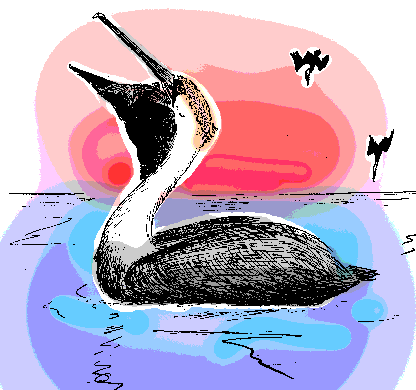Excerpts from Jim Conrad's
Naturalist Newsletter

from the August 7, 2011 Newsletter issued from Mayan Beach Garden Inn 20 kms north of Mahahual; Caribbean coastal beach and mangroves, ~N18.89°, ~W87.64°, Quintana Roo state, MÉXICO
THREE PELICANS
Up at the northern rocky point three Brown Pelicans paddled by in a row, bobbing on the waves, as seen above. The interesting thing was that the lead pelican had a white head and neck, while the second one's head was white but the neck was mostly brown, and then the third pelican's head and neck were all brown. What did it all mean?
It turns out that juvenile Brown Pelicans are brown overall with whitish bellies, so the third bird in the row is a freshly minted youngster. Just to our north in Sian Ka'an Biosphere Reserve, Brown Pelicans nest in colonies so a good guess is that our birds are from there. (Magnificent Frigate Birds, Roseate Spoonbills and Jabiru Storks also nest in Sian Ka'an.)
Our middle bird displays plumage typical of an adult Brown Pelican during the summer -- white head, and a brown neck with white from the head extending down the front of the neck. But the front bird displays the typical plumage of an adult in winter -- an all-white head and neck.
So, two adult birds leading a youngster, and the two adults can't agree on whether it's time to dress for summer or winter...
from the January 22, 2006 Newsletter issued from Hacienda San Juan near Telchac Pueblo, northwestern Yucatán, México
FOUR BROWN PELICANS & A LAUGHING GULL
It's normal to see individual Brown Pelicans flying up and down the beach 15 or 20 feet above the water and just offshore. Spotting fish they spectacularly dive headfirst into the waves. Usually they don't catch anything and then sit for a minute or so bobbing on the waves. Finally they fly off, flapping hard while running atop the water a few steps before getting aloft.
Sometimes the pelicans join into small flocks, however, and then their fishing becomes methodical, almost obsessive, in the manner of American football players during a close game. In these small flocks, after their dives they rest just a few seconds before taking off again, and typically fly only for about 15 seconds before diving again. The other day I watched four Brown Pelicans work back and forth in this manner before Hotel Reef.
It was low tide and the birds flew close to one another in a tight formation. They'd pass over a dark bed of seaweeds, one would shift his wings showing he was about to dive, the others would do the same, and they'd all dive together, hitting the water at about the same time, and within just a few feet of one another. My impression was that instead of going after fish they'd spotted they were making random dives into the seaweeds, maybe depending on the shock of all their bodies crashing into the bed to cause fish hiding among the seaweed to abandon their cover. Sometimes one or two other pelicans would join the flock, but sometimes the flock was reduced to as few as three.
All the time I watched, a single young Laughing Gull in his second-winter plumage tagged along.
The gull always waited two or three seconds after the pelicans had taken off before he himself would take wing. He'd follow behind the flock maybe 50 or 100 feet, then once the pelicans had dived he'd sail in among them maybe three to five seconds later.
Most of the time the gull would land atop a pelican -- usually on the back but sometimes atop the head! I think the gull's game was to catch stunned or wounded fish that might briefly escape a pelican's beak, or maybe the gull, like the pelicans themselves, was just trying to catch fish scared from cover by the pelicans' crashes.
The gull landed on different pelicans who didn't make much of an effort to keep him off, other than occasionally shuddering their bodies or halfheartedly tossing their heads. They seemed to have accepted the notion that if a seagull wants to land on you there's not much a pelican can do.
adapted from Jim's online book A Birding Trip through Mexico; This excerpt from "The Gulf-Coast Beach at Montepio" in southern coastal Veracruz state, México
BROWN PELICANS FEEDING

Brown Pelicans fish not far offshore and I've been noticing what a lot of work it is for them. They'll be sailing along five to ten feet above the water's surface, then in an instant they go into a dive and simply crash headfirst into the water. Surely such a splash severely jars the bird's body. The body remains atop the water with wings akimbo as if the whole frame were shattered. When the head and neck become visible often the neck is bent into what would seem a very uncomfortable position. Most dives don't seem to come up with any food. I never see the pouch rounded as in cartoons, but I do see loose skin below the long beak. Sometimes when a fish is swallowed the pouch balloons a little.